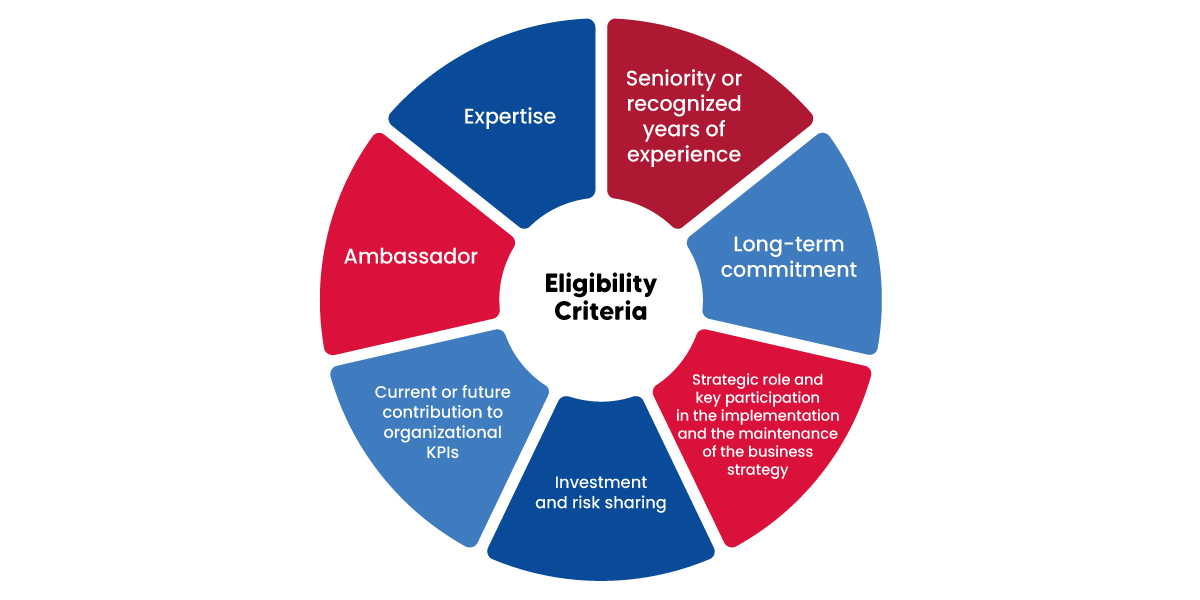
In our January article, “Long-Term Incentive Plans: Integrated Vision, Benefits, and Key Success Factors“, we provided an overview of the various Long-Term Incentive Plans (LTIPs) available, highlighting some of the benefits associated with their implementation. LTIPs represent powerful tools for attracting, retaining, and mobilizing key members of an organization. Therefore, it is important to make a conscious choice to implement the right program to optimize the return on investment.
Our series of three articles on LTIPs aims to shed light on these lesser-known tools among private companies in Quebec. Thus, in the context of our second article, we will focus on the key success factors when implementing and continuously managing an LTIP. The elements described are intended for private companies in Quebec and exclude large corporations and publicly traded companies.
Key Success Factors
Several key success factors should be considered in the selection, design, and management of a LTIP, including:
- Clear and consistent eligibility and maintenance criteria;
- Alignment of the plan with the business strategy;
- Alignment of the plan with shareholder objectives;
- Positioning and relative importance of the plan within the total compensation package (we invite you to read our article “A Distinctive and Coherent Total Rewards Strategy“);
- Choosing the right plan among all available types of plans (we invite you to read our article “Long-Term Incentive Plans: Integrated Vision, Benefits, and Key Success Factors“);
- Plan design;
- Communication and appreciation of the design and results;
- Ongoing management.
Questions to Consider
In order to optimize the investment you plan to make in an incentive compensation program, we invite you to ask yourself the following questions:
Regarding the LTIP you are considering…
- Does it propel your business strategy by encouraging your employees to focus on what is profitable for your organization?
- Does it take into account and enable the achievement of the personal objectives of current shareholders (selling, transferring their business, changing roles, slowing down, etc.)?
- Is it outlined by clear, objective, and consistent eligibility criteria that justify why an employee is eligible and how they could aspire to it?
- Is it supported by a competitive total compensation package (we refer you to our article “A Distinctive and Coherent Total Rewards Strategy“)?
- Is it backed with a strong communication strategy to ensure a full understanding of the program by the targeted employees, and to help mobilize employees who may aspire to join the program?
Strategy and Tools at the Center of Decisions
As a leader, management professional, or HR expert, you must ensure that your HR strategic plan covers all the elements previously outlined to maximize the return on investment in your LTIP.
How can you achieve this? By having a clear understanding of the various available incentive plans and their respective characteristics to make an informed choice that is aligned with your business and HR strategies. At the end of our article, we offer one of our summary tools to assist you.
Furthermore, would you like to learn more about organizations’ practices regarding LTIPs? Sign up for our 2024 Survey on Total Compensation in Quebec, which will address the topic.
Errors to Avoid
Among the elements described earlier, we wish to emphasize three of them for which we observed several errors and on which we would like to raise awareness:
- Absence of eligibility and maintenance criteria;
- Lack of alignment of the LTIP with the business strategy;
- Failure to consider shareholder objectives.
As for the selection of key roles, key individuals, and targeted performance, we will delve deeper into these in our third article, where we will address concepts related to succession planning in businesses.
Three Key Success Factors to Consider When Designing an LTIP
Key Success Factor 1: Clear and Cohesive Eligibility and Continuation Criteria
Eligibility and continuation criteria tend to vary significantly from one LTIP to another, as they must be tailored to the company and its context. These criteria often underpin numerous errors and failures in the realm of LTIPs. When well-designed, they greatly facilitate value creation for the company and its shareholders, as well as alignment of long-term interests with key individuals. Thus, they are pivotal in optimizing the return on investment.
Here are some success conditions for establishing eligibility and continuation criteria:
- Align criteria with the company’s strategic objectives: Eligibility and continuation criteria should align with the company’s long-term strategic objectives, ensuring that LTIP beneficiaries share the same interests as the company and are motivated to contribute to its long-term success (further elaborated in the next factor).
- Emphasize individual and collective performance: Ideally, eligibility criteria include thresholds for individual and collective performance that employees must meet to qualify for the LTIP. Similarly, continuation criteria should ideally be tied to ongoing performance to ensure that beneficiaries persist in their sustainable contribution to the company’s success. Alignment with and promotion of the organization’s values and culture also enhance the impact of these criteria.
- Encourage long-term engagement: By establishing rigorous continuation criteria, the LTIP aims to encourage employees’ long-term engagement, which can contribute to fostering retention of key talent.
- Manage risks and compliance: Eligibility criteria may include requirements for compliance and ethical behavior to ensure that only employees who adhere to the company’s standards are eligible. Additionally, continuation criteria ideally address risks related to the company’s long-term performance.
- Prioritize transparency and fairness: It is also advantageous for eligibility and continuation criteria to be transparent and equitable for all relevant employees, thereby reinforcing employee trust in the program and ensuring fair distribution of financial incentives.
The key takeaway is that eligibility and continuation criteria are designed to align employees’ interests with those of the company, encourage long-term engagement, manage risks, and ensure transparency and fairness in the program.
Here is a diagram that may inspire you in developing your eligibility and continuation criteria:

Key Success Factor 2: Alignment of the Plan with the Business Strategy
The second key success factor is aligning the LTIP with the business strategy. An LTIP must be closely aligned with the company’s business strategy to ensure effectiveness and optimal results.
Here are some ways to achieve this alignment:
- Establish common strategic objectives: The LTIP should be designed to incentivize participants to directly contribute to achieving the company’s strategic objectives. This may include goals such as revenue growth, profitability improvement, market expansion, strategic capacity building, etc.
- Implement key performance indicators (KPIs) or other forms of measurement (e.g., OKRs): The performance criteria and key indicators of the LTIP should align with the company’s KPIs, ensuring that participants’ efforts are directed towards priority actions identified within the business strategy.Have a long-term vision: As the name suggests, an LTIP should encourage behaviours and decisions that create long-term value for the company. Therefore, it should be aligned with the company’s long-term vision, emphasizing sustainability, desired growth, and sustainable value creation for shareholders.
- Promote corporate culture and values: The LTIP should also reflect the company’s culture and values. Financial incentives should encourage behaviours and actions that align with the company’s values and contribute to strengthening its organizational culture.
- Ensure clear communication to program participants: Clear and transparent communication on how the LTIP aligns with the business strategy is essential to foster employee engagement. Participants need to understand how their efforts directly contribute to achieving the company’s strategic objectives.
In summary, an effective LTIP should be closely aligned with the business strategy, focusing on common strategic objectives, KPIs or other performance measures, long-term vision, corporate culture, risk and compliance, and communication to key individuals.
If you wish to evaluate your business strategy or learn more about it, we suggest these two articles from our partner MXO: “How to Evaluate if My Business Strategy is Good?” (in French) and “Strategy Isn’t Just for Big Business” (in French).
A good strategy is a guarantee of success in business and contributes to attracting top talent!
Key Success Factor 3: Alignment of the Plan with Shareholder Objectives
The third key success factor concerns aligning the LTIP with shareholder objectives. In addition to the two elements discussed previously, it is important to choose the type of plan and design that promote the achievement of shareholder objectives. To learn more about plan types, we invite you to consult our latest article on the subject, “Long-Term Incentive Plans: Integrated Vision, Benefits, and Key Success Factors“.
Here are some considerations:
- Share financial goals: LTIPs should be designed to align employees’ interests with those of shareholders by setting shared financial goals. This may include objectives such as revenue growth, profitability increase, cash flow generation, or stock value enhancement.
- Encourage ownership participation: LTIPs can include mechanisms that allow employees to become shareholders in the company or to participate in shareholder performance. For example, stock option plans, employee trusts, or stock grants can be considered to directly link employee behaviour to stock value. Ownership participation is particularly effective in an internal succession context or when shareholders rely on the company’s value to secure their financial independence.
- Establish long-term vesting periods: LTIPs should feature long-term vesting periods to encourage employee engagement over the long term, ensuring they remain aligned with shareholder objectives. For example, the plan could include a gradual vesting period over several years.
- Set performance based on key financial metrics: LTIP financial incentives should be based on financial metrics that reflect value creation for shareholders. This may include metrics such as earnings per share, return on investment, revenue growth, or return on equity.
In summary, a well-designed LTIP should ensure alignment with the aspirations of key employees and shareholder objectives by implementing shared goals, aligning performance indicators with company valuation, and establishing long-term financial measures that enable value creation for both key individuals and shareholders.
Conclusion
Long-Term Incentive Plans (LTIPs) are powerful tools to support the achievement of business strategy and the attainment of shareholder and key personnel objectives. However, LTIPs are more complex to implement than short-term schemes and require careful and ongoing management.
We hope this article has raised awareness of the errors to avoid and the numerous key success factors to consider when implementing such a program.
For Further Information
Do you want to delve even deeper into the topic? Contact one of our LTIP professionals:
Miguel Yargeau, Partner
1 844 220-8008, Ext. 486
myargeau@solertia.ca
Stay Informed
Stay tuned! In our next and final article in this three-part series on LTIPs, we will discuss the role of Long-Term Incentive Plans in the context of succession planning for businesses. The human aspect and key roles will be explored in more depth.
Partager




